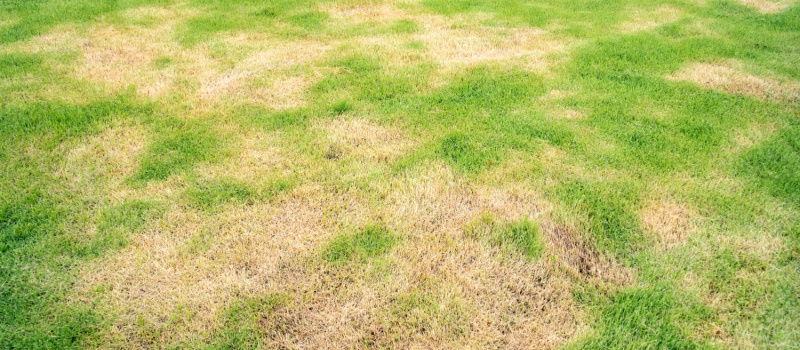How Do You Know If Insects Are Destroying Your Yard?

A well-maintained yard is a source of pride for homeowners. It's where you relax, play, and enjoy the outdoors. However, an invisible threat lurks beneath the surface – destructive insects. If they get their way, these tiny pests will wreak havoc on your lawn and landscape. So, how do you know if insects are destroying your yard, and what can you do about it? Let's explore the signs, common culprits, and preventive measures.
1. Discolored or Wilted Grass
One of the most apparent signs that insects are causing trouble in your yard is discolored or wilted grass. If you notice yellow or brown grass patches, it often indicates insect infestations. Different insects cause distinct types of damage. For example:
- Chinch bugs often cause irregular yellow or brown patches with a distinctive margin of healthy grass.
- Grubs, the larvae of beetles, create spongy, brown areas in your lawn.
- Armyworms can chew through grass blades, leaving behind thin or bare spots.
2. Thinning or Dead Grass
Insect feeding can lead to thinning or dead areas in your lawn. Observing patches where the grass seems to be disappearing or struggling to grow is a sign of potential insect damage. Gently tug on the grass blades in these areas – if they pull up easily like a loose carpet, grubs may be responsible.
3. Increased Pest Activity
Keep an eye out for increased pest activity in your yard. If you notice more ants, beetles, or other insects crawling around your lawn, it's a clear sign that something may be amiss. Certain insects, like ants, can be attracted to the honeydew excreted by pests such as aphids and mealybugs.
4. Distorted or Stunted Growth
Insects can cause distortion and stunted growth in your plants. For example:
- Aphids are known to suck sap from plant stems, causing leaves to curl, pucker, or distort.
- Spider mites leave behind fine webbing on plant surfaces and can cause yellow stippling on leaves.
- Scale insects can make plants appear weak and unhealthy, with a sticky residue on the foliage.
5. Visible Insect Presence
Sometimes, you may spot the insects themselves. Look closely at your plants, soil, and lawn for signs of these pests. Some insects are more easily visible than others, so be patient and thorough in your inspection.
Common Culprits: Insects That Damage Yards
Several insects are known for causing significant damage to yards. Here are a few common culprits:
- Grubs: These beetle larvae feed on the roots of grass, causing patches of dead or dying grass.
- Chinch Bugs: These bugs suck sap from grass blades, leading to yellow or brown patches.
- Armyworms: These caterpillars can rapidly devour grass, leaving behind damaged or bare areas.
- Aphids: They feed on plant sap, causing leaves to curl, wilt, or discolor.
- Whiteflies: These tiny insects can cause yellowing, wilting, and reduced growth in plants.
- Spider Mites: They pierce plant cells and suck out their contents, leading to stippled or discolored leaves.
- Scale Insects: These pests attach themselves to plants and sap their nutrients, weakening the plant.
Preventing and Managing Insect Damage
The key to managing insect damage in your yard is early detection and prompt action. Here are some preventive measures and steps to take if you suspect an insect problem:
1. Maintain Proper Lawn and Plant Care
- Regularly water your yard and plants. Properly hydrated plants and lawns are less susceptible to insect damage.
- Apply adequate fertilizer. Healthy, well-nourished plants are more resilient.
- Aerate and overseed. Keep your lawn healthy to reduce its attractiveness to pests.
2. Monitor Your Yard
- Regularly inspect your yard. Check your yard and garden for signs of insect damage. Early detection can prevent infestations from spreading.
- Use traps. Utilize sticky traps or pheromone traps to monitor insect populations.
3. Choose Resistant Plants
- Select pest-resistant plant varieties. Some plants are naturally less appealing to pests.
- Try for diversity. Plant a variety of species to discourage pests from focusing on a single type of plant.
4. Practice Integrated Pest Management (IPM)
- Encourage natural predators like ladybugs, lacewings, and parasitic wasps to control pest populations.
- Use organic pesticides and beneficial nematodes to manage pests.
5. Consult a Professional
If you need clarification on the extent of insect damage or the best course of action, consult a local pest control professional or extension service for expert guidance.
Identifying the presence of destructive insects in your yard is crucial for maintaining a thriving garden. By paying attention to signs such as wilting plants, chewed leaves, or unusual holes in the ground, you can quickly determine if insects are wreaking havoc on your yard. However, it is always recommended to seek professional assistance to accurately identify the specific pests and provide effective solutions. Don't let insects destroy your hard work – contact The Experienced Gardener for expert advice and reliable pest control methods.


